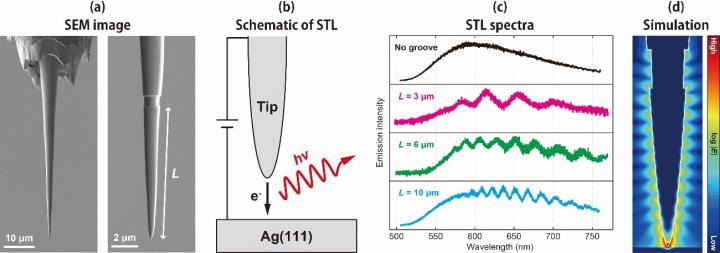Step forward toward achieving nanoscale imaging and spectroscopy with tailored ‘nanolight’

(a) SEM images of a gold FIB-tip. A single groove is made at a distance (L) from the apex.
Spatial resolution of optical microscopy and spectroscopy is determined by how much one can confine light in space, which is usually restricted to about half-micrometer at the best due to the diffraction limit. However, light can be confined into nanometer scale by using metallic nanostructures through excitation of localized surface plasmon resonance (LSPR). Having such “nanolight” at a sharp metallic tip is particularly useful because it can be used in scanning tunneling luminescence (STL) and scattering-type scanning near-field optical microscopy (s-SNOM) performing nanoscale imaging and spectroscopy to look at nanomaterials and even single molecules. However, precise manipulation of nanolight in nanoscale junction has remained an outstanding problem. Because the nature of nanolight (LSPR) is determined by the nanoscopic structure of the tip, its manipulation requires a fine processing technique at the nanoscale. In addition, nanolight confined into nanocavities is of key importance due to the strong enhancement effect of an electromagnetic field, which enables ultrasensitive nanoscale imaging and spectroscopy.
A research team at the Fritz-Haber Institute in Berlin, headed by Dr. Takashi Kumagai, now demonstrated that manipulation of nanolight spectrum can be attained by shaping accurately plasmonic gold tips with a focused ion beam (FIB) milling technique. As an exemplary demonstration, they produced a very sharp tip with a single groove on its shaft as shown in the scanning electron microscope picture. The spectral response of nanolight confined in the nanocavity formed by the grooved tip and an atomically flat silver surface was investigated by using STL that is the combination of electronic and optical spectroscopies using scanning tunneling microscopy. The STML spectra with the grooved tips exhibit a characteristic modulation resulting from Fabry-Pérot type interference of surface plasmon polaritons (SPPs) on the tip shaft as the standing wave formation is visualized in the electrodynamic simulation. The spectral modulation can be precisely controlled by the groove position on the shaft. They also demonstrated that the SPP Fabry-Pérot interference can be improved by optimizing the overall tip shape.
This work shows a great potential of the combination of scanning probe techniques and nano-fabrication of plasmonic tips using FIB in order to study the nature of nanolight and light-matter interactions in nanocavities, which are an important frontier of plasmonics and nanooptics. In addition, the FIB-fabricated plasmonic tips are generally applicable to s-SNOM techniques, thus paving the way for nanoscale imaging and spectroscopy with a high degree of accuracy. Moreover, spectral control of the intense near-field at the apex of plasmonic tips may open up new opportunities for the realization of coherent laser-triggered electron point sources for low-energy electron microscopy and holography techniques.
###
Media Contact
Takashi Kumagai
[email protected]
Original Source
https:/
Related Journal Article
http://dx.



